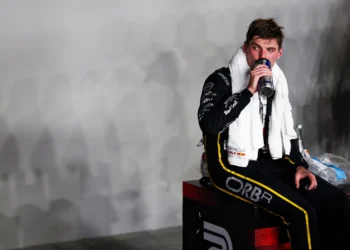When NASCAR Hall of Famer Mark Martin reminisces about his time on the track, fans and critics alike take note. A recent post on X (formerly Twitter) from the legendary driver has reignited the longstanding debate over NASCAR’s horsepower restrictions, highlighting how the sport has evolved—or, as many argue, regressed—over the years.
The Comment That Set Fans Ablaze
Martin, who earned his stripes during a 31-year NASCAR career, reacted to a qualifying clip from his stellar 2009 season, writing:
“I loved qualifying. And man, that car was fast in ’09.”
While seemingly innocuous, the comment struck a nerve with fans who vividly remember the raw, unbridled power of stock cars during that era. With engines pushing up to 900 horsepower and generating thrilling speeds, the late 2000s are viewed by many as the last golden age of NASCAR performance.
The Evolution—and Controversy—of NASCAR Horsepower
From its earliest days, NASCAR’s appeal was rooted in its high-performance machines. Over the decades, horsepower climbed, thrilling fans with cars that seemed on the edge of control.
- 1948-1980s: Early engines, like the Hudson Twin-H and Ford’s Cammer 427, set benchmarks for dominance.
- 1990s-2000s: By the mid-2000s, NASCAR cars were routinely producing up to 900 horsepower.
- 2015-2019: NASCAR controversially capped engines at 750 horsepower, reducing it further to 550 HP for some tracks.
- 2022-Present: With the introduction of the Next Gen car, horsepower is now capped at 670, leaving traditionalists lamenting the loss of raw power.
The shift, aimed at cost reduction and increasing parity, has received mixed reviews. While the move brought closer racing at times, it diluted some of the visceral excitement fans had come to expect.
Fan Reaction: Yearning for the Past
Martin’s comment unleashed a wave of nostalgia and frustration from NASCAR fans, many of whom have been vocal critics of the horsepower reductions:
- “Man, I miss cup cars having b—s under the hood,” one fan lamented.
- “One-lap qualifying. All out. High HP. The car is loose. High-pitched noise. The crowd going crazy. High speed. Man, this was a fun time. Sometimes, simple is better,” another said, summarizing what many feel is missing from modern NASCAR.
- Others highlighted the sound of pre-Next Gen cars: “The Next Gen’s have a nice bass to them, but the high-pitched tone that came from these cars was great.”
NASCAR’s Stance: Costs vs. Competition
Despite the uproar, NASCAR’s leadership remains firm. Earlier this year, NASCAR’s Chief Racing Development Officer, John Probst, addressed the issue, emphasizing cost implications:
“If you add horsepower, you add the cost. There’s no guarantee it would be any better … That’s a heck of a gamble to take with the entire industry.”
Probst’s comments reflect a broader strategy to balance competition and sustainability, but it’s clear that many fans and drivers believe the pendulum has swung too far in favor of cost control.
Drivers Weigh In
Mark Martin isn’t alone in his advocacy for higher horsepower. Current stars like Joey Logano have echoed similar sentiments, calling for NASCAR to reclaim its identity as the pinnacle of motorsport power:
“We want more power. It increases tire wear. It makes the track wider. And it’s more bada–,” Logano stated bluntly, adding that the push for low horsepower is not coming from drivers.
“Every one of us wants to have more power,” Logano added.
The Road Ahead
For now, NASCAR’s focus remains on reducing costs and maintaining close racing, but the horsepower debate is far from settled. Mark Martin’s comment has reignited a discussion that refuses to fade, and with fans and drivers voicing increasing discontent, the sanctioning body may need to reconsider its stance in the coming seasons.
Whether it’s nostalgia or a genuine desire to see the sport return to its high-octane roots, the push for more horsepower is gaining traction. As Martin’s post proved, the roar of powerful engines isn’t just a sound—it’s a legacy, and fans are eager for it to make a comeback.













